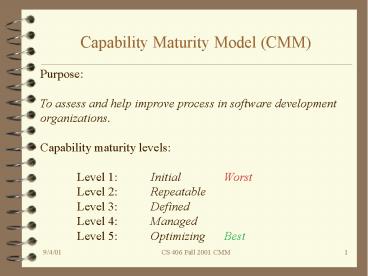Capability Maturity Model (CMM) - PowerPoint PPT Presentation
Title:
Capability Maturity Model (CMM)
Description:
The software process for both management and engineering ... Technology change management. Process change management. Managed: Quantitative process management ... – PowerPoint PPT presentation
Number of Views:719
Avg rating:3.0/5.0
Title: Capability Maturity Model (CMM)
1
Capability Maturity Model (CMM)
Purpose To assess and help improve process in
software development organizations. Capability
maturity levels Level 1 Initial Worst Level
2 Repeatable Level 3 Defined Level 4
Managed Level 5 Optimizing Best
2
CMM Levels 1
Initial The software
process is characterized as ad hoc,
and occasionally even as chaotic. Few processed
are defined, and success depends on individual
effort.
Lacks Reasonable process.
3
CMM Levels 2
Repeatable Basic
project management processes are established to
track cost, schedule and functionality. the
necessary process discipline is in place to
repeat earlier successes on projects with similar
applications.
Lacks Complete process.
4
CMM Levels 3
Defined The software
process for both management and
engineering activities is documented,
standardized and integrated into a standard
software process for the organization. All
projects use an approved, tailored version of the
organization's standard software process for
developing and maintaining software.
Lacks Predictable outcomes.
5
CMM Levels 4
Managed Detailed
measures of the software process and product
quality are collected. Both the software process
and products are quantitatively understood and
controlled.
Lacks Mechanism for process improvement.
6
CMM Levels 4
Optimized Continuous
process improvement is enabled by
quantitative feedback from the process and from
piloting innovative ideas and technologies.
7
Key Process Areas 1
Optimizing Defect prevention Technology change
management Process change management
Managed Quantitative process management Softwar
e quality management
8
Key Process Areas 2
Defined Organization process focus Training
programs Integrated software management Peer
reviews
Repeatable Requirements management Software
project planning Software quality
assurance Software configuration management
9
CMM Documents ?
http//www.sei.cmu.edu/cmm/cmms/cmms.html































